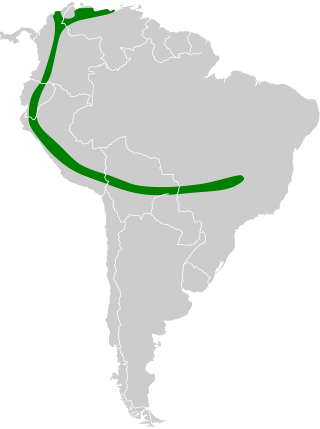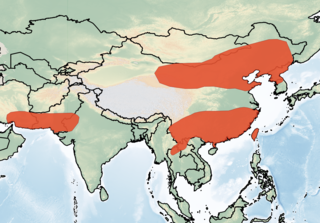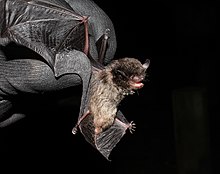
The big brown bat is a species of vesper bat distributed widely throughout North America, the Caribbean, and the northern portion of South America. It was first described as a species in 1796. Compared to other microbats, the big brown bat is relatively large, weighing 15–26 g (0.53–0.92 oz) and possessing a wingspan of 32.5–35 cm (12.8–13.8 in).

The serotine bat, also known as the common serotine bat, big brown bat, or silky bat, is a fairly large Eurasian bat with quite large ears. It has a wingspan of around 37 cm (15 in) and often hunts in woodland. It sometimes roosts in buildings, hanging upside down, in small groups or individually. The name serotine is derived from the Latin serotinus, which means 'evening', while the generic name derives from Greek ἔπιεν and οίκος, which means 'house flyer'.

The Brazilian brown bat is a bat species from South and Central America.

The Argentine brown bat, is a bat species from South and Central America.

The northern bat is the most abundant species of bat in northern Eurasia occurring from France to Hokkaidō and south to Kazakhstan.

Eptesicus is a genus of bats, commonly called house bats or serotine bats, in the family Vespertilionidae. The genus name is likely derived from the Greek words ptetikos 'able to fly' or petomai 'house flier', although this is not certain.

The Surat helmeted bat is a species of vesper bat. It ranges from Thailand and Laos west to Nepal.
The Guadeloupe big brown bat is a species of vesper bat. It is found only on the island of Guadeloupe. It is one of the eleven species of bat found on Guadeloupe, and one of three that are endemic.
The sombre bat is a species of vesper bat. It is found only in India. Its natural habitat is subtropical and tropical moist montane forests.

Cambarellus diminutus is a species of crayfish in the family Cambaridae. It is endemic to the United States. It is native to Mississippi and Alabama, and is listed as Data Deficient on the IUCN Red List.

Taddei's serotine is a species of medium-sized bat belonging to the family Vespertilionidae. It is restricted to the Atlantic Forest of southern Brazil.

The little black serotine is a species of insectivorous vesper bat. It is found in Colombia, Ecuador, Peru, Venezuela, Bolivia and Brazil at elevations from 100 to 3300 m.

The harmless serotine is a species of vesper bat. It has a restricted range in western Ecuador and northwestern Peru. An insectivorous species, it is a resident of tropical dry forest habitat, and is threatened by deforestation.

The Chiriquinan serotine is a species of house bat.

The meridional serotine is a species of bat native to the Iberian Peninsula, Morocco, Algeria, Tunisia and Libya.
Eptesicus lobatus is a species of bat of genus Eptesicus and family Vespertilionidae.
Myotis diminutus is a species of mouse-eared bat found in Ecuador and Colombia. It was recently described as a new species in 2011.
The Anatolian serotine bat is a species of bat found in the Middle-East, Cyprus and Rhodes Island, Greece.

The Oriental serotine is a species of bat in the family Vespertilionidae. It is widespread and found throughout Asia.

Eptescini is a tribe of bats in the family Vespertilionidae. This tribe has a cosmopolitan distribution.
















